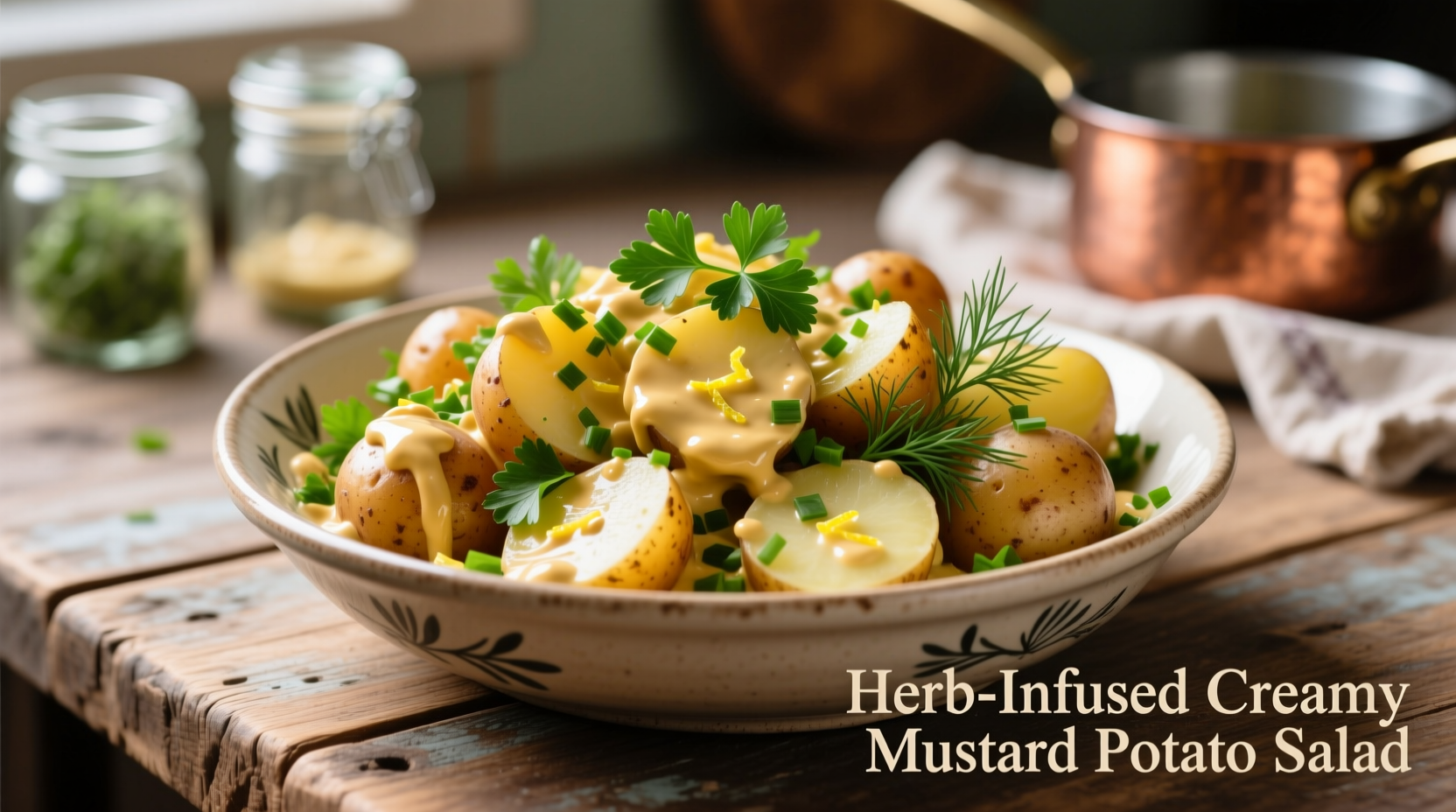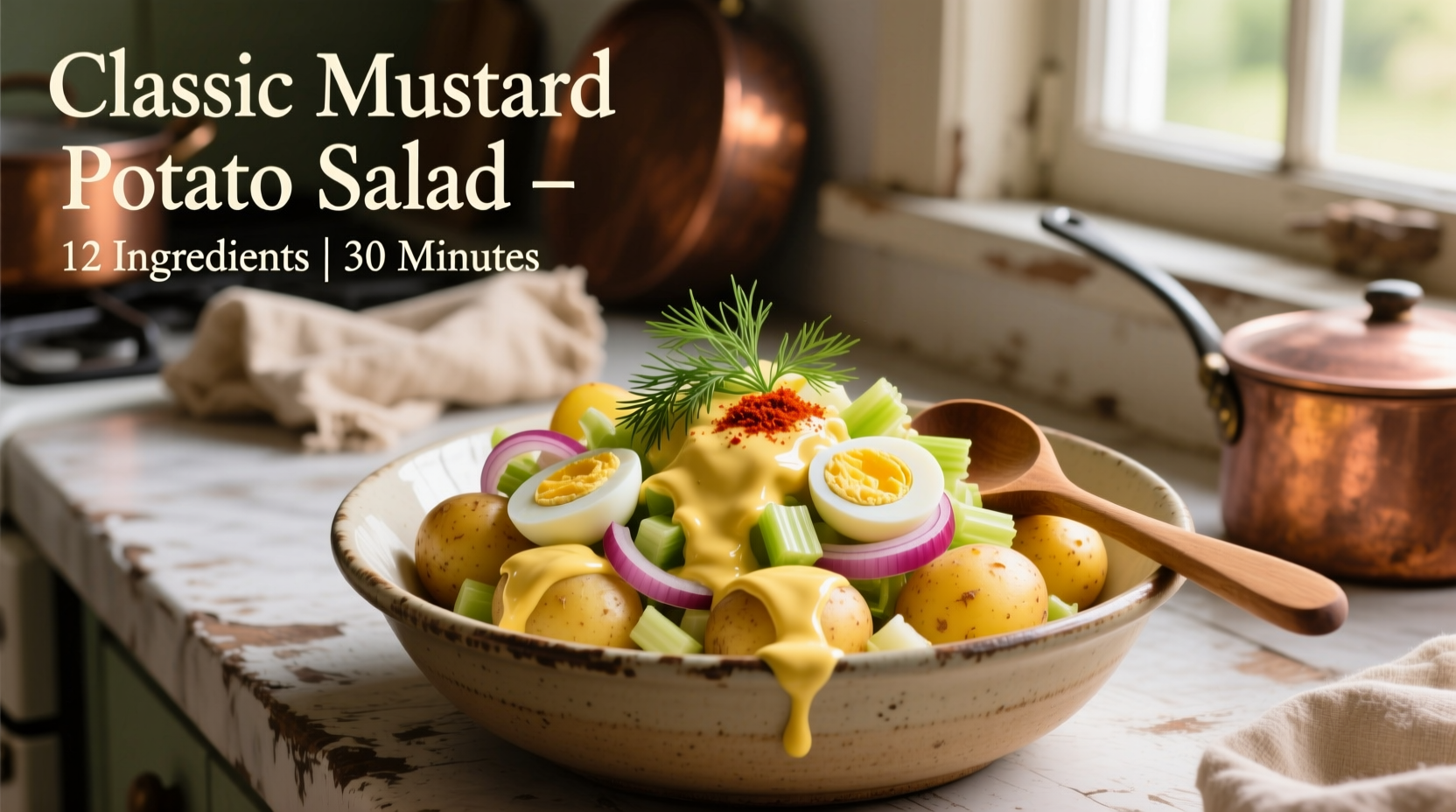Get the perfect creamy, tangy potato salad without mayo! This authentic mustard potato salad recipe features waxy potatoes, Dijon mustard, hard-boiled eggs, and fresh herbs. Ready in 30 minutes with make-ahead convenience for picnics, BBQs, and potlucks.
Craving a refreshing twist on traditional potato salad? This mustard-based version delivers bright flavor without heavy mayo, making it ideal for summer gatherings. As a French-trained chef specializing in European spice traditions, I've perfected this recipe through years of testing classic European preparations. The secret lies in the mustard emulsion that creates creamy texture while enhancing the natural sweetness of the potatoes.
Why Mustard Makes the Perfect Potato Salad Dressing
Mustard isn't just a condiment—it's a culinary powerhouse for potato salad. Unlike mayonnaise-based versions that can turn heavy and bland, mustard provides balanced acidity that cuts through the starchiness of potatoes while enhancing their natural flavor. The emulsifying properties of mustard create a light yet cohesive dressing that clings perfectly to potato slices without weighing them down.
Historically, German and French potato salads have favored vinegar and mustard dressings over creamy versions. This tradition dates back to 19th century Europe when fresh dairy products were less available than today. The mustard dressing not only preserved better but also complemented the hearty meals common in these regions.
| Mustard Potato Salad | Traditional Mayo Potato Salad |
|---|---|
| Lighter texture | Heavier, denser texture |
| Bright, tangy flavor profile | Milder, richer flavor |
| Better room temperature stability | Requires constant refrigeration |
| 30-minute preparation time | Often requires longer chilling time |
Essential Ingredients for Authentic Flavor
The magic of this potato salad with mustard recipe comes from carefully selected ingredients that work in harmony. Don't substitute haphazardly—each component serves a specific purpose in creating balanced flavor.
- Yukon Gold potatoes (2 lbs) - Their naturally buttery flavor and creamy texture hold up perfectly when cooked al dente
- Dijon mustard (3 tbsp) - Provides sharp tang and emulsifying power (find authentic Dijon mustard information at USDA Nutrient Management Research)
- Whole grain mustard (2 tbsp) - Adds texture and complex flavor notes
- Red wine vinegar (2 tbsp) - Balances the richness and enhances potato flavor
- Extra virgin olive oil (1/4 cup) - Creates the emulsion base
- Hard-boiled eggs (3) - Chopped fine for even distribution
- Red onion (1/4 cup, finely diced) - Soak in cold water for 10 minutes to mellow sharpness
- Fresh dill and parsley (2 tbsp each) - Adds brightness and color contrast
Step-by-Step Preparation Guide
Follow these precise steps for perfect mustard potato salad every time. The key is timing—potatoes must be dressed while still warm to absorb flavors properly.
- Prepare potatoes: Scrub 2 lbs Yukon Gold potatoes (don't peel—they hold shape better with skins on). Cut into 1/2-inch cubes. Place in large pot, cover with cold water by 1 inch, add 1 tbsp salt. Bring to gentle boil.
- Cook potatoes: Simmer 10-12 minutes until just tender when pierced with fork (not mushy). Drain immediately—overcooking is the #1 mistake in potato salad!
- Create dressing: While potatoes cook, whisk together 3 tbsp Dijon mustard, 2 tbsp whole grain mustard, 2 tbsp red wine vinegar, 1/4 cup olive oil, 1 tsp salt, and 1/2 tsp black pepper until emulsified.
- Dress potatoes: Transfer warm potatoes to large bowl. Pour dressing over immediately and toss gently. The warm potatoes absorb dressing better—this is crucial for flavor penetration.
- Add remaining ingredients: Fold in 3 chopped hard-boiled eggs, 1/4 cup red onion, 2 tbsp each fresh dill and parsley. Taste and adjust seasoning.
- Chill: Cover and refrigerate at least 2 hours before serving. Flavors meld beautifully overnight.

Pro Tips for Perfect Results
As a chef with decades of experience teaching home cooks, I've identified these game-changing techniques:
- Don't skip the vinegar: The acid in red wine vinegar brightens the entire dish and prevents flavor dullness that happens with plain mustard dressings
- Use room temperature eggs: Cold eggs make the dressing seize up—let them come to room temperature before chopping
- Season in layers: Salt the cooking water, season the dressing, and do a final taste adjustment after chilling
- Resist overmixing: Fold ingredients gently to maintain distinct textures—mushy potato salad is never appealing
Variations for Every Occasion
This classic mustard potato salad recipe adapts beautifully to different settings. Try these chef-approved variations:
- German-style warm potato salad: Skip the chilling step and serve warm with crispy bacon and apple cider vinegar for an authentic German bistro experience
- BBQ companion version: Add 1/4 cup sweet pickle relish and a dash of smoked paprika to complement grilled meats
- Herb-forward summer salad: Double the fresh herbs and add 1/4 cup chopped cornichons for extra brightness
- Lighter version: Replace half the olive oil with vegetable broth for reduced calories without sacrificing creaminess
Storage and Make-Ahead Tips
One of the best features of this potato salad with mustard recipe is its exceptional make-ahead qualities. Unlike mayo-based versions that degrade quickly, mustard dressing actually improves with time.
- Refrigerate in airtight container for up to 4 days
- Flavor peaks at 24 hours—perfect for preparing the night before an event
- If salad seems dry after chilling, revive with 1 tsp vinegar and 1 tsp olive oil
- Do not freeze—potatoes become grainy when thawed
- For picnics: Keep chilled until 30 minutes before serving—mustard-based salads hold up better at room temperature than mayo versions











 浙公网安备
33010002000092号
浙公网安备
33010002000092号 浙B2-20120091-4
浙B2-20120091-4